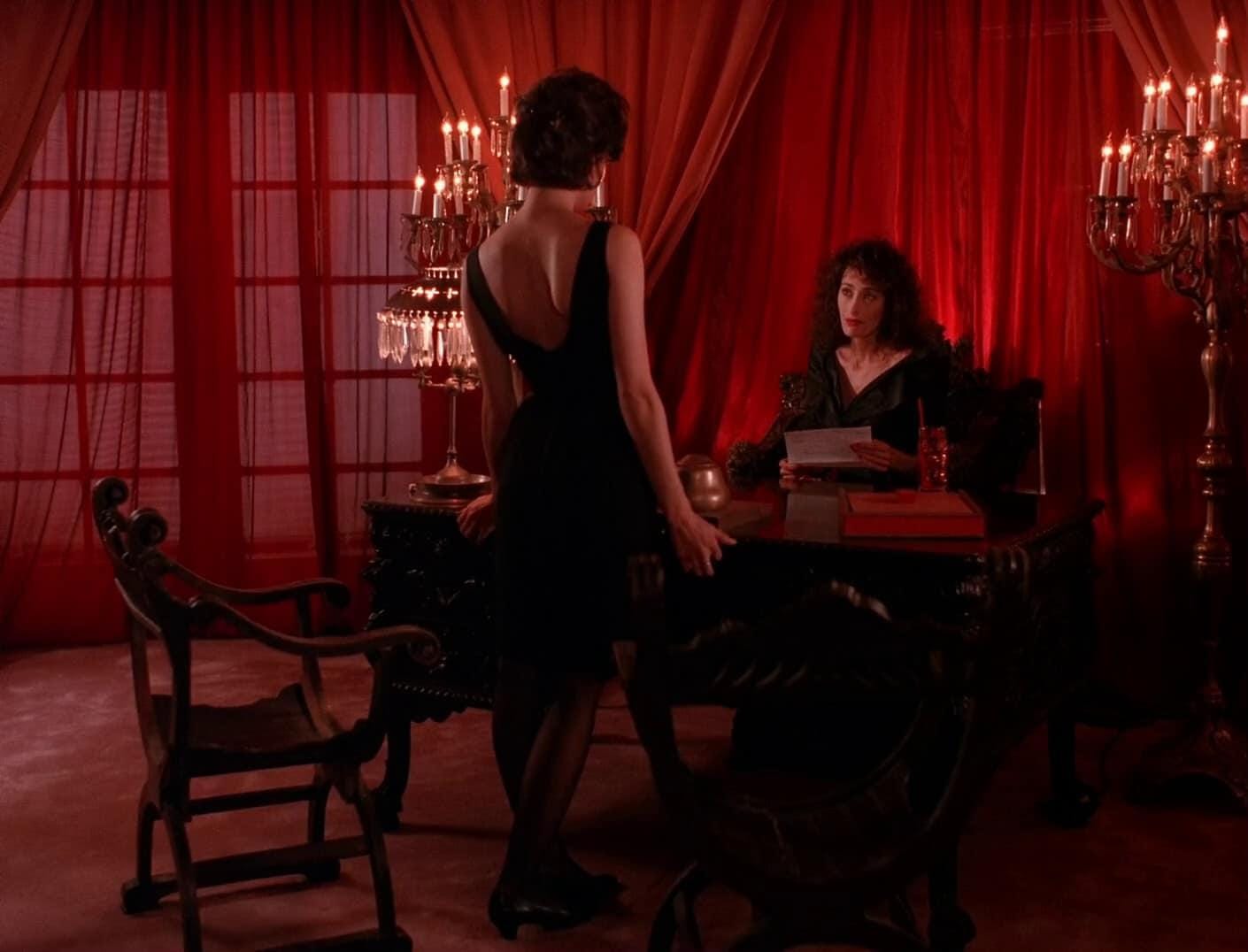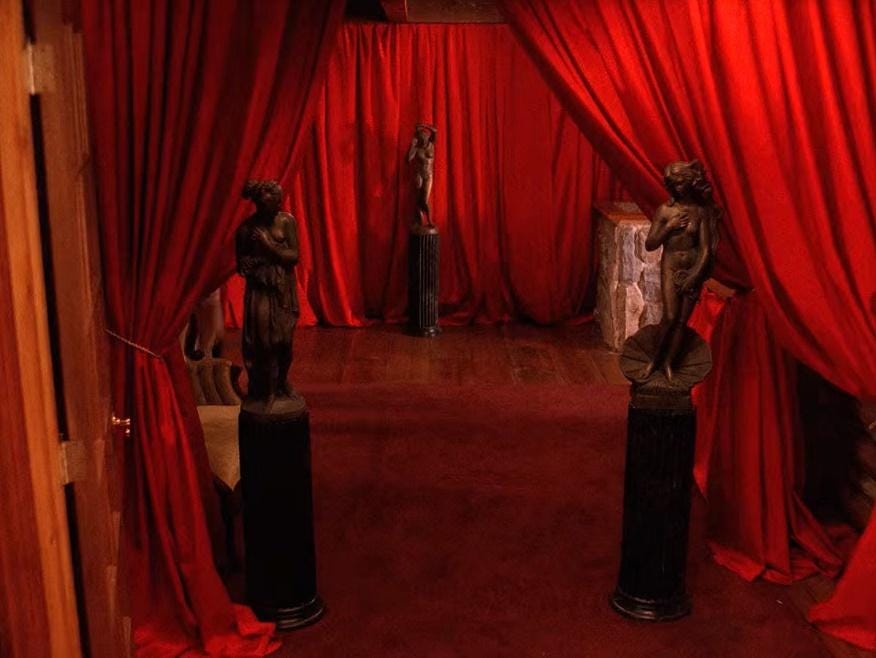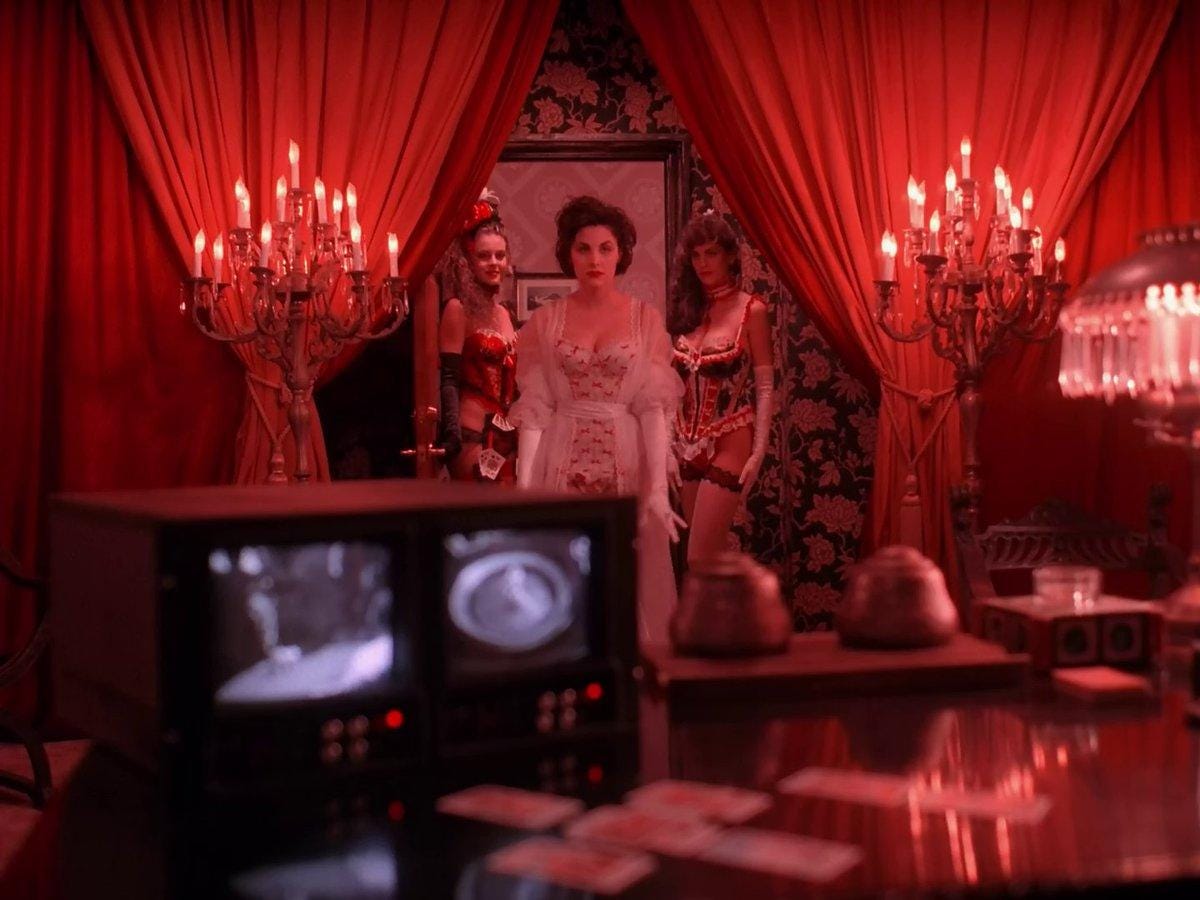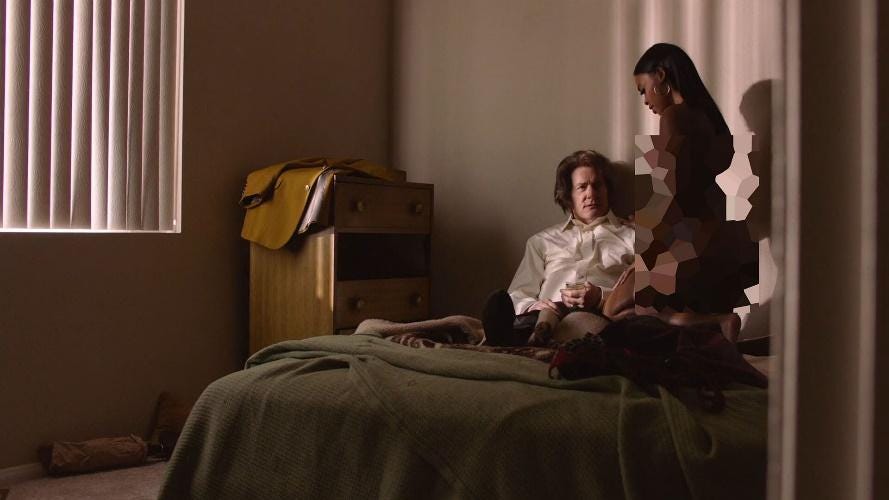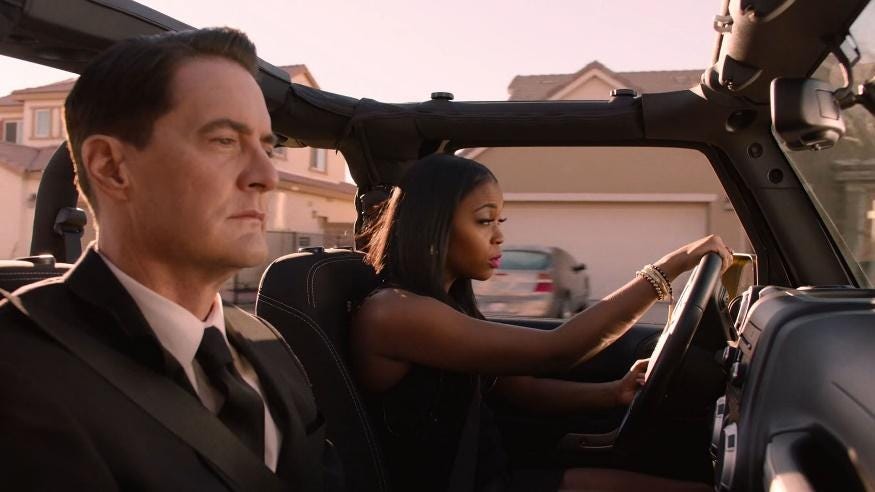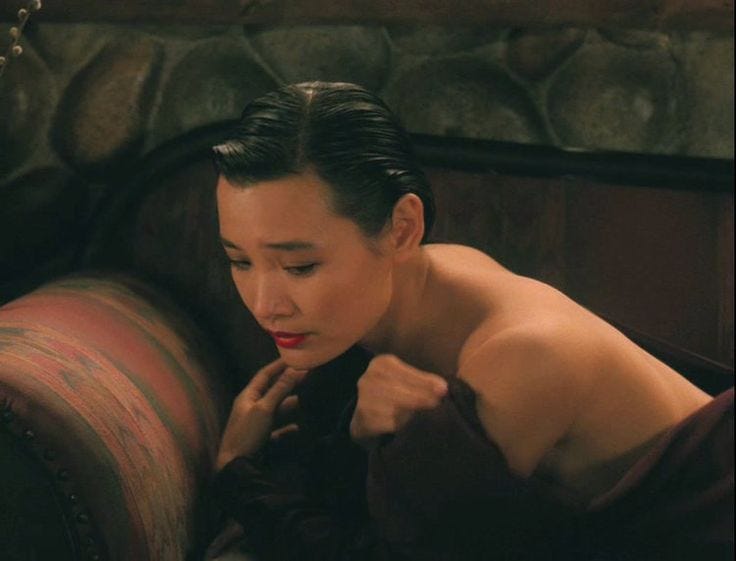Sex Work Aesthetics in Twin Peaks
This article contains spoilers for the Twin Peaks franchise.
This article originally appeared on the Tryst.link blog on March 4th, 2025. Read it in the original form here.

Unbeknownst to me, the day I pitched this piece to Tryst, January 15th, is the day that director David Lynch passed away. If you are unfamiliar with the world of his show Twin Peaks, or an apparent non-believer in the mystical as writer Philippa Snow is – who wondered in a moment of “spooky” clarity if David Lynch had passed two days before he did – this will seem like a coincidence.
Have you ever been to Twin Peaks? David Lynch’s fictional world of a small Washington 1990’s border town in Twin Peaks, and it’s expanded universe in Twin Peaks: The Return is a wild ride to say the least. I would count myself as a Twin Peaks stan, having first watched the series in 2014. The name ‘Laura Palmer,’ that of the teenage girl whose murder is the focal point of the show’s first season, was my teenage Twitter handle.
Full disclosure, I have not watched the movie Twin Peaks: Fire Walk With Me or finished Twin Peaks: The Return at the time of writing this. I delayed finishing this article in an effort to get through Fire Walk With Me, but I found the sudden jumps between clips that were apparently discarded from the show’s main run and (to me) disturbing-for-no-reason inside shots of human mouths unpleasant and lacking enough merit to continue watching past the first ten minutes. Similarly, I did my best to get through the 2017 release Twin Peaks: The Return, but after four hour-long episodes which I felt were just plainly not good, I couldn’t commit another fourteen hours of my life to David Lynch’s meandering uptake of where the characters of the small town of Twin Peaks, Washington left off in 1991 when the television show was cancelled.
To say that Twin Peaks has a cult following would be a gross understatement. The show has multiple blogs devoted to it, and fans are still so devoted to the show’s lore that they flock to the real-life filming locations across the United States and author entire essays about what they felt was lacking in their experience. So why is Twin Peaks so beloved?
From my point of view, it is because the first two seasons of Twin Peaks are masterpieces. Supernatural soap operas, if you will. In the words of author Elissa Washuta, who incorporated Twin Peaks heavily into her book of essays White Magic: “It is a show about the unexplained, the mystical, and the cycles of violence and neglect to which women find themselves tethered.” I personally adore Twin Peaks for its sumptuous early 1990s aesthetics, its award-winning exquisite theme song, and of course, for the main girl herself: high-school beauty Laura Palmer.
Laura Palmer, is of course, dead the entire time during the first two seasons of Twin Peaks. She is shown in flashbacks and photos as the epitome of the U.S. American fantasy of the perfect white, blonde, small-town princess. Laura serves meals on wheels to recluses and the elderly, volunteers her time tutoring rich heiress Audrey Horne’s differently-abled brother, and is beloved by all.
Unsurprisingly to me, when Laura Palmer is not being the homecoming queen, girlfriend to the captain of the football team Bobby Briggs, most popular girl in school, and the loving daughter of her Hallmark-card upper-white middle class heteronormative settler Dream-House family, she is working shifts across the border at the Canadian brothel One Eyed Jack’s and taking freelance clients through the adult magazine Flesh World.
From my perspective, Laura’s sex work is portrayed as part of her demise: she is seen as destroying herself in this way, along with managing a cocaine addiction, because life inside her beautiful house is actually – again, unsurprising to me – a nightmare. Laura is the classic wild, beautiful, mysterious, and ultimately unknowable girl with a secret life whom everyone wants to fuck and nobody seems to be able to help. She is the victim of what Snow describes as, “..the crime scene of the American Dream.”
Apart from this sad and unimaginative narrative about sex work, other sex workers in Twin Peaks’ first two seasons are to my liking. Laura’s coworker, Ronette Paulaski, is attacked by the same person who murders Laura, but at least Ronette’s sex work is framed differently than Laura’s: whereas Laura advertises in Flesh World for the hell of it and because she is coded as ‘damaged’ (Laura Palmer even has her own depressing theme music rife with danger and longing), Ronette is a working-class girl with a trucker for a father who just seems to need extra money.
Similarly, the girls and women who work at One Eyed Jack’s possess aesthetics are far more sumptuous and less tragic than Laura’s. Everything about the brothel screams wealth and decadence, from the draped red curtains, the magnificent candelabras, the wood paneling, and the casino downstairs. Apart from the manager Black Rose being a bit of a violent bitch – and again, drug addiction is needlessly negatively coded with sex work in Black Rose’s character – she still manages to be ultimately iconic in every way and One Eyed Jack’s is a gorgeous setting for a brothel. Unfortunately, we hardly get to hear any thoughts in the brothel workers’ heads because they have very few, if any lines. Kind of upsettingly, a core scene in the brothel is when the owner flips a coin with his brother to decide who gets to “try” the ‘New Girl’ first. After the owner wins the coin toss, the camera zooms in close to the New Girl’s face and we see her give an uneasy, seemingly nervous smile.
One Eyed Jack’s becomes a site in the series associated with violence, exploitation, and danger when the character Audrey Horne (the daughter of the brothel’s owner) infiltrates the brothel by pretending to be a sex worker to try to discover more about what happened to Laura. Audrey uses the name Hester Prynne (the titular character of the novel The Scarlet Letter about adultery in the Puritan ages) as her working name. It seems that David Lynch had a propensity for the archetypal association of the color red with sex, sin, and extremity. One of the most iconic scenes (dare I say, in television history?) takes place at One Eyed Jack’s when Audrey is asked to prove her sex work skills by Black Rose and she does so by tying a cherry stem with her tongue. She is hired on the spot (of course). Audrey will later insist to her crush that she never slept with anyone at the brothel, thus implying that she is still ‘pure’ and ‘loveable.’
Pretending to be a sex worker when you are not is never a good idea, and Audrey quickly finds herself over her head. Drugs, as with Laura’s cocaine addiction in the series, are shown to be associated with the underworld of sex work along with ‘bad people’ and nefarious characters such as the Renault brothers. I would describe Lynch’s portrayal of sex work in the first two seasons of Twin Peaks as an overall negative one, for the reasons I’ve outlined above but also because the setting of One Eyed Jack’s is eerily similar to the spiritual dimension known as The Black Lodge in the town of Twin Peaks.
Like One Eyed Jack’s, The Black Lodge is decorated with endless walls and entryways of red curtains and Venus statues. The Black Lodge, according to Twin Peaks lore, is where souls must pass through for purification before they can be released. It is also a place where various spirits, including Laura’s soul, and evil doppelgangers reside. The goal is to make it to The White Lodge (are we noting the obvious anti-black binaries yet?) where good souls and good spirits exist peacefully. So basically, The Black Lodge is close to hell, at best a kind of purgatory, and it seems that One Eyed Jack’s is seen as one too. Too bad David Lynch makes both The Black Lodge and One Eyed Jack’s look so good – I’d work at One Eyed Jack’s just to get one of those red, black, and white outfits decorated with playing cards.

I learned that sex work is a recurring theme throughout director David Lynch’s realm of Twin Peaks, as it turns out he put sex worker characters in Twin Peaks: Fire Walk With Me (information on that here and here), as well as in Twin Peaks: The Return with the character of Jade. If you’ve never seen Twin Peaks before, it is a show which relies heavily on symbolism, mysticism, archetypes, 1980s-style soap opera drama in which fully-realized characters and evil twins appear from thin air with inexplicable eye patches and/or accents, and themes of violence against women. Sex work seems to figure into David Lynch’s world because it allows the show to flow effortlessly through the use of tropes about sex work into narratives of danger, of the unexplainable, and of women in all sorts of circumstances.
I can at least credit David Lynch with some kind of growth about sex work from the four episodes I saw of Twin Peaks: The Return through the character of Jade. As a Black sex worker, I loved seeing Jade’s beautiful and powerful body post-session with the character of Dougie as she takes her payment. It was noteworthy to me that this booking is the vehicle by which David Lynch decided to having Agent Dale Cooper suddenly fall out of The Black Lodge and swap places with his look-a-like Dougie. There is something mystical about sex work; we do create a paradigm-bending magic through the liminal spaces of our sessions. David Lynch never explains anything, but in my own Twin Peaks fan-theory, perhaps it is the energetic exchange of sex work and Jade’s own magic which enables Agent Cooper to finally get out of The Black Lodge where he’s been trapped for twenty years.
Watching Jade, a Las Vegas sex worker, be completely irritated with and absolutely done with her client’s shenanigans was a treat. It felt completely real, down to her outfit and her bright-yellow roofless SUV. When she comes out of the shower and finds her client lying on the floor in a completely different outfit, with a different haircut, and having lost approximately forty pounds in a matter of minutes, she is completely unfazed and doesn’t seem to notice. His time is up. She does him the courtesy of bringing him to a casino and giving him five dollars to make a phone call home, and goes on her way.
It is possible I may go back and watch the rest of Twin Peaks: The Return when I have fourteen hours to spare to be simultaneously puzzled and perturbed. I would only do it, really, for Jade, to see if she makes a reappearance. I appreciate that David Lynch’s aesthetics of sex work evolved with the times, and that the sex workers of the Twin Peaks multiverse evolve from sad high-schoolers and nonspeaking brothel workers to empowered freelancers making bank and dealing with post-session supernatural occurrences without so much as a twitch of their perfectly drawn-on eyebrows.
At the same time, fans of David Lynch and Twin Peaks always neglect to mention the atrocious and – to me – the most offensive I have ever seen – caricature of an Asian man played by white female actress Piper Laurie in Season 1 of Twin Peaks. This casual, blatant, and disgusting racism and anti-Asian sentiment has always negatively affected my conception of David Lynch as a director, and it contextualizes my feelings about another of Twin Peaks’ sex worker characters: Josie Packard. After Laura Palmer, Josie is my favorite character on the show, and she is, if I am recalling correctly, the only regular woman of color in Twin Peaks’ original run. While I adore her beauty, her luxury, and her extravagance, I can’t help but be troubled by Josie’s backstory and her fate.
Josie is a woman who grew up in Hong Kong, and, who it is later revealed, was arrested for prostitution on more than one occasion – this is framed by the show’s lead, FBI Agent Dale Cooper, as a reason why Josie likely ‘didn’t really love’ the Deputy Sheriff Truman, who Josie was having an affair with. We learn as viewers that she is the “property” of a white man obsessed with her named Thomas Eckhart; in one scene, one of Eckhart’s minions comes to bother Josie and deliver her instructions from Eckhart. The implication of the way the scene is set is that the minion has had intercourse with her, which is dubious in terms of consent. I hate seeing Josie’s fall from glamorous, untouchable mill owner in killer outfits with a bitter old white woman jealous of her (yes, Josie did orchestrate the death of that woman’s brother, but things can be multi-layered, okay!), to ending up as that same woman’s MAID, serving her breakfast in a shameful maid outfit. It is relevant to me that the same white character who despises Josie is the one who dresses up in a racist portrayal of an Asian man.
Everything about Josie’s character is written, to me, in white racist tropes about Asian women and Asian women sex workers: as sexual objects, ‘foreign’ in a pejorative sense, as victims of trafficking or circumstance, coming from questionable backgrounds, and made to be subservient to whites. I especially detest Josie’s fate – Thomas Eckhart effectively kidnaps her, and we last see her in a bedroom with him at the Great Northern Hotel where the implication is that they’ve been holed up having intercourse, with again, dubious consent implied. Josie shoots Eckhart, freeing herself, and then she gets turned into a screaming doorknob. It is an unfitting end for such an iconic character, and a troubling portrayal of the life of a sex worker.





